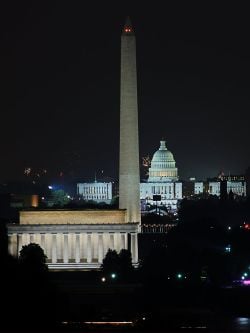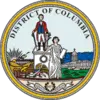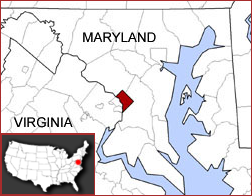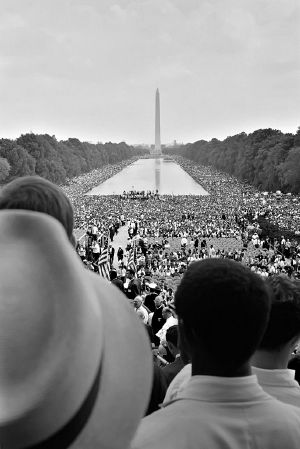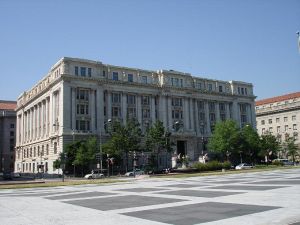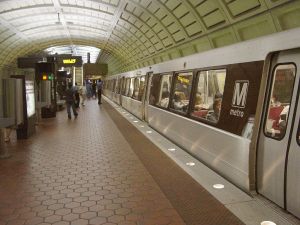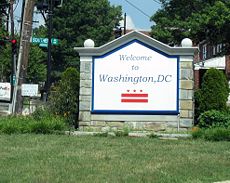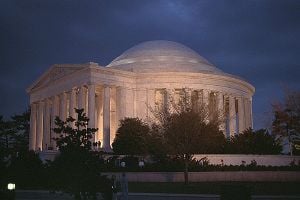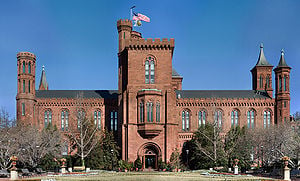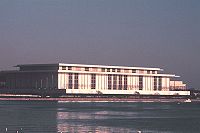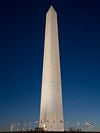Difference between revisions of "Washington, D.C." - New World Encyclopedia
Vicki Phelps (talk | contribs) |
Vicki Phelps (talk | contribs) |
||
| Line 239: | Line 239: | ||
==Education== | ==Education== | ||
| − | [[Image:Visitation1.jpg|thumb|right| | + | [[Image:Visitation1.jpg|thumb|right|Georgetown Visitation Preparatory School]] |
| − | The public school system in the city is operated by | + | The public school system in the city is operated by District of Columbia Public Schools and consists of 167 schools and learning centers, which consist of 101 elementary schools, 11 middle schools, 9 junior high schools, 20 senior high schools, six education centers, and 20 special schools. In 2005-2006, 54,800 students were enrolled in the public school system, with enrollment decreasing.<ref name="dcfpi">{{cite web |url=http://www.dcfpi.org/?page_id=125 |title=What’s in the FY 2007 Budget for Education? |publisher=DC Fiscal Policy Institute |accessdate=2007-05-06}}</ref> Per-pupil expenditure is very high, with excessive headquarters administrative positions, but many school buildings are in disrepair, slow to be fixed, and learning performances very low. Turnover of school superintendents is frequent, with many resigning in frustration. At the same time, enrollment in independently run and publicly funded charter schools has increased 13 percent each year since 2001. The District of Columbia Public Charter School Board monitors 37 charter schools in Washington, D.C. In 2005-2006, 19,300 students were enrolled in charter schools. |
| − | |||
===Colleges and universities=== | ===Colleges and universities=== | ||
| − | The city is home to several [[universities]], [[college]]s, and other institutions of [[higher education]], both public and private. The | + | The city is home to several [[university|universities]], [[college]]s, and other institutions of [[higher education]], both public and private. The University of the District of Columbia is the city's public university; it is the nation's only urban [[land-grant university]] and is counted among the historically black colleges and universities. |
[[Image:Founders Library, Howard University.jpg|thumb|right|Howard University's Founders Library]] | [[Image:Founders Library, Howard University.jpg|thumb|right|Howard University's Founders Library]] | ||
| − | Among private institutions, [[Georgetown University]] is older than the District itself, having been founded in 1789 | + | Among private institutions, [[Georgetown University]] is older than the District itself, having been founded in 1789. It is the nation's oldest [[Roman Catholic]]-affiliated body of higher education. The university is especially well-known for the Edmund Walsh School of Foreign Service and the Georgetown University Law Center. |
| − | [[George Washington University]], founded by an act of Congress in 1821, is the largest institution of higher education in the nation's capital | + | [[George Washington University]], founded by an act of Congress in 1821, is the largest institution of higher education in the nation's capital. Known for the Elliott School of International Affairs, as well as the The George Washington University Law School and its School of Business, it is the second-largest landholder and employer in the District, second only to the federal government. [[American University]], a private institution chartered by an act of Congress in 1893, is situated on an 84-acre (34 ha) campus in upper Northwest Washington. [[The Catholic University of America]] (CUA) is unique as the national university of the Roman Catholic Church and as the only higher education institution founded by U.S. Roman Catholic bishops. Established in 1887 following approval by [[Pope Leo XIII]] as a graduate and research center, the university began offering undergraduate education in 1904. |
| − | |||
| − | |||
| − | |||
| − | |||
| − | |||
| − | |||
| − | |||
| − | |||
| − | [[ | + | Other notable private colleges in the District include [[Gallaudet University]], the first liberal arts college for the [[deaf]] and [[hard-of-hearing]], Howard University, a historically black university dating to the nineteenth century which among other achievements trained many early black physicians, and Southeastern University, a smaller institution with a concentration in business studies. |
| − | |||
| − | |||
| − | |||
| − | |||
| − | |||
| − | |||
| − | |||
| − | |||
| − | |||
| − | |||
| − | |||
==Culture== | ==Culture== | ||
===Tourism=== | ===Tourism=== | ||
Revision as of 17:56, 16 December 2008
| Washington, D.C. | |||
|
|||
| Nickname: DC, The District | |||
| Motto: Justitia Omnibus (Justice for All) | |||
| Location of Washington, D.C., in relation to the states Maryland and Virginia | |||
| Coordinates: {{#invoke:Coordinates|coord}}{{#coordinates:38|53|42.4|N|77|02|12.0|W|type:city | |||
|---|---|---|---|
| name= }} | |||
| Country | United States | ||
| Federal District | District of Columbia | ||
| Government | |||
| - Mayor | Adrian M. Fenty (D) | ||
| - D.C. Council | Chairperson: Vincent C. Gray (D) Ward 1: Jim Graham (D) |
||
| Area | |||
| - City | 68.3 sq mi (177.0 km²) | ||
| - Land | 61.4 sq mi (159.0 km²) | ||
| - Water | 6.9 sq mi (18.0 km²) | ||
| Elevation | 0–410 ft (0–125 m) | ||
| Population (2006)[1] [2] | |||
| - City | 581,530 | ||
| - Density | 9,015/sq mi (3,481/km²) | ||
| - Metro | 8,207,040 (est 2,006) | ||
| Time zone | EST (UTC-5) | ||
| - Summer (DST) | EDT (UTC-4) | ||
| Website: http://www.dc.gov/ | |||
Washington, D.C., is the capital city of the United States of America. "D.C." is an abbreviation for the District of Columbia, the federal district coextensive with the city of Washington. The city is named after George Washington, military leader of the American Revolution and the first president of the United States. Columbia in this context is an early poetic name for the United States of America, a reference to Christopher Columbus, an early European explorer of the Americas.
The city is commonly referred to as Washington, The District, or simply D.C. In the nineteenth century, it was called the Federal City or Washington City.
The centers of all three branches of the U.S. federal government are in the District. It also serves as the headquarters for the World Bank, the International Monetary Fund, the Organization of American States, the Inter-American Development Bank, and other national and international institutions including labor unions and professional associations.
Washington is the frequent location of political demonstrations and protests, large and small, particularly on the National Mall. Furthermore, Washington is a popular destination for tourists, the site of numerous national landmarks and monuments. It is a major American cultural center, with a number of important and free museums including the world's largest museum complex Smithsonian Institution, galleries, universities, cathedrals, performing arts centers and institutions, and native music scenes.
The District of Columbia and the city of Washington are governed by a single municipal government and for most practical purposes are considered the same entity. This has not always been the case. Until 1871, when Georgetown ceased to be a separate city, there were multiple jurisdictions within the District.[3]
Although there is a municipal government and a mayor, Congress has the supreme authority over the city and district, which results in citizens having less self-governance than residents of the states. The District also does not have voting representation in Congress. Many residents in the District have been trying for years to get voting representation, pointing out that District residents are subject to federal income taxes. In FY2004, federal tax collections were $16.9 billion[4] while federal spending in the District was $37.6 billion.[5]
The population of the District of Columbia is about 581,530 persons.[1] The Washington Metropolitan Area is the eighth largest in the United States with more than five million residents, and the Baltimore-Washington Metropolitan Area has a population exceeding eight million. If Washington, D.C., were a state, it would rank last in area behind Rhode Island, 50th in population ahead of Wyoming, first in population density, and 35th in gross state product.
Geography
Topography

According to the United States Census Bureau, the city has a total area of 68.3 square miles (177.0 km²). 61.4 square miles (159.0 km²) of it is land and 6.9 square miles (18.0 km²) of it (10.16%) is water.
Washington is surrounded by the states of Maryland (on its southeast, northeast and northwest sides) and Virginia (on its western side); it interrupts those states' common border, which is the Potomac River's southern shore both upstream and downstream from the District. The Potomac River as it passes Washington is virtually entirely within the District of Columbia border because of colonial riparian rights between Maryland and Virginia.
The District has three major natural flowing streams: the Potomac River, the Anacostia River and Rock Creek. The Anacostia River and Rock Creek are tributaries of the Potomac River. There are also three man-made reservoirs: Dalecarlia Reservoir, which crosses over the northwest border of the District from Maryland; McMillan Reservoir near Howard University; and Georgetown Reservoir upstream of Georgetown.
The highest point in the District of Columbia is 410 feet (125 m) above sea level at Tenleytown. The lowest point is sea level, which occurs along all of the Anacostia shore and all of the Potomac shore except the uppermost portion.
The geographic center of the District of Columbia is located near 4th Street NW, L Street NW and New York Avenue NW (not under the Capitol Dome, as is sometimes said).
Geographical features of Washington, D.C. include Theodore Roosevelt Island, Columbia Island, the Three Sisters Islands and Hains Point.

Climate
Washington is in the northern periphery of the humid subtropical climate zone. Its climate is typical of the Mid-Atlantic U.S., with four distinct seasons. Summer tends to be hot and humid with daily high temperatures in July and August averaging in the high 80s to low 90s (in °F; about 30° to 33 °C). The combination of heat and humidity makes thunderstorms very frequent in the summer, some of which occasionally produce tornadoes in the area. The combination of heat and humidity can also be reminiscent of a true tropical climate. Spring and fall are mild with high temperatures in April and October averaging in the high 60s to low 70s (about 20 °C). Winter brings sustained cool temperatures and occasional heavy snowfall, however, light snowfall is common. Average highs tend to be in the low 40s (6 to 8 °C) and lows in the mid 20s (-5 to -2 °C) from mid-December to mid-February. While tropical cyclones (or their remnants) occasionally track through the area in late summer and early fall, they have often weakened by the time they reach Washington partly because of the city's inland location. Flooding of the Potomac River, however—caused by a combination of high tide, storm surge, and storm runoff—has been known to cause extensive property damage in Georgetown and Old Town Alexandria, Virginia. Spring is generally the most favorable time of year, with low humidity, mild temperatures, and blooming foliage. This period generally lasts from late March until mid May.
The average annual snowfall is 15 inches (381 mm) and the average high temperature in January is 41 °F (5 °C); the average low for January is 27 °F (-3 °C). The highest recorded temperature was 106 °F (41 °C) on July 20, 1930 and August 6, 1918 and the lowest recorded temperature was -15 °F (-26 °C) on February 11, 1899.
Nature
Washington, D.C. has many natural areas and birdwatching spots inside the city. D.C.'s parks and natural areas include the United States National Arboretum, the extensive Rock Creek Park, the Smithsonian National Zoological Park, Theodore Roosevelt Island, the C&O Canal, the Potomac River, and the Anacostia River.
The Potomac River has been called one of the wildest urban rivers in the nation. The Potomac Gorge. The river, once called a national disgrace by President Lyndon B. Johnson, is now home to a vibrant warm water fishery. Professional bass tournaments have been held within view of the Jefferson Memorial, and naturally reproducing bald eagles have returned to its banks.
History
The District of Columbia, founded on July 16, 1790, is a federal district as specified by the United States Constitution. The U.S. Congress has ultimate authority over the District of Columbia, though it has delegated considerable authority to the municipal government. The land forming the original District came from the state of Maryland and Commonwealth of Virginia. However, the area south of the Potomac River (39 square miles or about 100 km²) was returned to Virginia in 1847 and now is incorporated into Arlington County and the city of Alexandria. After 1847, the remaining land that formed the area now known as the District of Columbia was formed exclusively from land that once belonged to Maryland.
Planning
A Southern site for the new country's capital was agreed upon at a dinner between James Madison and Alexander Hamilton, hosted by Thomas Jefferson. The site was part of the deal that led to the new national government's assumption of debts from the Revolutionary War. (The southern states had largely paid off their war debts; collectivizing debt was to the northern states' advantage, so a southern capital was a compromise.) The city's plan was largely the work of Peter (Pierre) Charles L'Enfant, a French-born architect, engineer, and city planner who first arrived in the American colonies as a military engineer with Major General Lafayette. L'Enfant drew up a basic plan for Washington, D.C., in 1791; the city's layout owed much to the Baroque style, which was the dominant style in many North American and European planned cities of the day. The plan incorporated broad avenues and major streets that radiate out from traffic circles, providing vistas toward important landmarks and monuments. While all of the original colonies had avenues named for them, the most prominent states received more prestigious locations. Pennsylvania Avenue was given the honor of connecting the White House to the planned Capitol building.
The initial plan for the "Federal District" was a diamond, measuring 10 miles (16 km) on each side, totaling 100 square miles (256 km²). The actual site on the Potomac River was chosen by President Washington. The city was officially named "Washington" on September 9, 1791. Out of modesty, George Washington never referred to it as such, preferring to call it "the Federal City." Despite choosing the site and living nearby at Mount Vernon, he rarely visited the city.
The federal district was named the District of Columbia because Columbia was a poetic name for the United States used at the time, which was close to the 300th anniversary of Christopher Columbus' first voyage to the Americas in 1492.
Initially, the District of Columbia included four distinct sections, of which the city of Washington was only one. The others were Alexandria County, Georgetown, and the County of Washington. Georgetown occupied its current boundaries. Alexandria County included parts of the present-day City of Alexandria, as well as the current Arlington County, Virginia. Washington City occupied much of its current area but ended at present-day Rock Creek Park on the west and Florida Avenue and Benning Road on the north. The remainder of the district was Washington County.
In 1791–92, Andrew Ellicott and Benjamin Banneker surveyed the border of the District with both Maryland and Virginia, placing boundary stones at every mile point; many of these still stand.
The cornerstone of the White House, the first newly constructed building of the new capital, was laid on October 13, 1792.
Nineteenth century
On August 24, 1814, Canadian forces under British command burned the capital during the most notable raid of the War of 1812 in retaliation for the sacking and burning of York (modern-day Toronto) during the winter months, which had left many Canadians homeless. President James Madison and U.S. forces fled before the British forces arrived and burned public buildings, including the Capitol and the Treasury building. The White House was burned and gutted. The Washington Navy Yard was also burned — by American sailors — to keep ships and stores from falling into the hands of the British. The home of the Commandant of the Marine Corps, located at the Marine Barracks, was one of the few government buildings not burned by the raiding British soldiers out of a sign of respect and is now the oldest public building in continuous use in the nation's capital. The Patent Office was also spared, as a result of the Superintendent of Patents pleading with British soldiers and contending that destroying the store of knowledge therein would be a disservice to mankind.
During the 1830s, the District was home to one of the largest slave trading operations in the country.
In 1846, the population of Alexandria County, who resented the loss of business with the competing port of Georgetown and feared greater impact if slavery were outlawed in the capital, voted in a referendum to ask Congress to cede Alexandria back to the Commonwealth of Virginia. Congress agreed to do so. The slave trade, though not slavery, in the capital was outlawed as part of the Compromise of 1850.
Washington remained a small city — the 1860 census put the population at just over 75,000 persons — until the outbreak of the Civil War in 1861. The significant expansion of the federal government to administer the war and its legacies, such as veterans' pensions, led to notable growth in the city's population, as did a large influx of freed slaves. By 1870, the District's population had grown to nearly 132,000.
In July 1864, Confederate forces under General Jubal Anderson Early made a brief raid into Washington, culminating in the Battle of Fort Stevens. The Confederates were repelled, and Early eventually returned to the Shenandoah Valley. The fort is located near present day Walter Reed Army Medical Center in northwest Washington. This was the only battle where a U.S. president, Abraham Lincoln, was present and under enemy fire while in office.
In the early 1870s, Washington was given a territorial government, but Governor Alexander Robey Shepherd's reputation for extravagance resulted in Congress abolishing his office in favor of direct rule. Congressional governance of the District would continue for a century.
In 1878, Congress passed an Organic Act that made the boundaries of the city of Washington coterminous with those of the District of Columbia. This effectively eliminated Washington County; Georgetown, technically made a part of the city, was allowed to remain nominally separate until 1895 when it was formally combined with Washington.
The Washington Monument, with construction stalled by other priorities, finally opened in 1888. Plans were laid to further develop the monumental aspects of the city, with work contributed by such noted figures as Frederick Law Olmsted and Daniel Burnham. However, development of the Lincoln Memorial, Jefferson Memorial and other structures on the National Mall, and construction of Potomac Park did not begin until the early 20th century.
20th century
The many Depression relief agencies created by Franklin Roosevelt's New Deal, followed by World War II, brought a great increase to the city's population. The District's population peaked in 1950, when the census for that year recorded a record population of 802,178 people.[6] At the time, the city was the ninth-largest in the country. The population declined in the following decades, mirroring the suburban emigration from many of the nation's older urban centers following World War II and the racial integration of public schools.
The Twenty-third Amendment to the United States Constitution was ratified on March 29, 1961, allowing residents of Washington, D.C., to vote for president and have their votes count in the Electoral College as long as Washington, D.C., does not have more electoral votes than the least populous state.
After the assassination of civil rights activist Martin Luther King, Jr., in Memphis, on April 4, 1968, riots broke out in some sections of the city. The violence raged for four days, and buildings were burned. At one point, the rioters came within two blocks of the White House. President Lyndon B. Johnson ordered over 13,000 federal troops to occupy the city—the largest occupation of an American city since the Civil War. It took years for the city to recover.
One of the most important developments in bringing people back downtown was the building of the subway system. The first 4.6 miles (7.4 km) of the Washington Metro subway system opened on March 27, 1976. Today the system knits together Washington and its suburbs with a network of 86 stations and 106.3 miles (171.1 km) of track.
In 1973, Congress enacted the District of Columbia Self-Rule and Governmental Reorganization Act, providing for an elected mayor and council for the District. As a result, Walter Washington became the first elected mayor of the District in 1975. Marion Barry became mayor in 1979 and served three successive terms; however, after his arrest for drug use in an FBI sting operation on January 18, 1990, and his sentence to a six-month jail term, he did not seek re-election. His successor, Sharon Pratt Kelly, became the first black woman to lead a U.S. city of Washington's size and importance. Barry, however, ran again in 1994, defeating her in the Democratic primary and once again becoming mayor. During his fourth term, the city nearly became insolvent and was forced to give up some home rule to a congressionally-appointed financial control board. In 1998, Anthony A. Williams was elected the city's mayor and led the city into a fiscal recovery. In 2006, Adrian Fenty was elected mayor. Among Mayor Fenty's many promises are increased attention to every citizen of the city and a world class atmosphere in business and residence.
During the 1970s, Many in the District referred to it as "Chocolate City," in honor of the city's African-American culture and to promote cultural awareness. Popularized by two local disk jockeys, the nickname was also a reference to the 1975 album "Chocolate City" by Parliament-Funkadelic. While the nickname never caught on permanently, it was a poignant reminder of the contributions to the city over the years by such icons as Duke Ellington, Chuck Brown, and other African-American performers.
21st century
On September 11, 2001, a hijacked aircraft deliberately crashed into the Pentagon, just across the Potomac River in Arlington, Virginia, causing a partial collapse of one side of the building. Al-Qaeda leader Abu Zubaydah told American officials while under interrogation that the White House was the intended target,[7] while Khalid Sheikh Mohammed and Ramzi Binalshibh have said that the United States Capitol Building was the intended target[8] of the hijacked United Airlines Flight 93.
On September 29, 2004, Major League Baseball officially relocated the Montreal Expos to Washington for the 2005 season, despite opposition from Baltimore Orioles owner Peter Angelos. The new team was christened the Washington Nationals. Controversy between the city council and MLB threatened to scuttle the agreement until December 21, 2004 when a plan for a new stadium in Southeast D.C. was finalized. The Nationals will play at R.F.K. Stadium until the new stadium is ready on the Anacostia River waterfront in 2008.[9]
Additionally, the city has experienced tremendous growth in the areas of Massachusetts Avenue, NoMa (North of Massachusetts), the Southwest Waterfront, the Shaw/U Street Corridor and H Street, with tens of thousands of condos, apartments and retail shops opening. This growth has been dubbed gentrification by many, as the areas experiencing growth had been blighted for many years prior.
Law and government
Local government
The city is run by an elected mayor (Adrian Fenty) and a district council. The council is composed of 13 members: one elected from each of the eight wards and five members, including the chairman, elected at large. The council conducts its work through standing committees and special committees established as needed. District schools are administered by a school board that has both elected and appointed members. There are 37 elected Advisory Neighborhood Commissions that provide the most direct access for residents to their local government. The commissions serve as local councils, and their suggestions are required to be given "great weight" by the D.C. Council. However, the U.S. Congress has the ultimate plenary power over the district. It has the right to review and overrule laws created locally and has often done so.
D.C. residents pay federal taxes, such as income tax, as well as very high local taxes. The mayor and council adopt a budget of local money with Congress reserving the right to make any changes. Much of the valuable property in the District is federally owned and hence exempt from local property taxes; at the same time, the city is burdened with the extraordinary expenses related to its role as the capital, such as police overtime and street cleaning for D.C.'s frequent parades and festivals. These factors are often used to explain why the city's budget is frequently overstretched. However, the federal government also appropriates funds for the city. For instance, the federal government provided an estimated 25 percent of the District's operating budget in 2003.
Representation in federal government
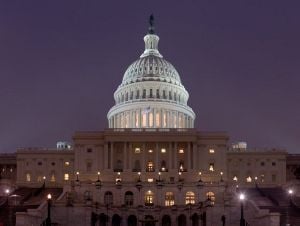
The U.S. Constitution gives Congress direct jurisdiction over Washington, D.C. While Congress has delegated various amounts of this authority to local government, including an elected mayor and city council, Congress still intervenes, from time to time, in local affairs relating to schools, gun control policy, and other issues.
Citizens of the District have no voting representation in Congress. They are represented in the House of Representatives by a non-voting delegate (Eleanor Holmes Norton (D-DC At-Large)) who sits on committees and participates in debate, but cannot vote. D.C. has no representation at all in the Senate. Attempts to change this situation, including statehood and the proposed District of Columbia Voting Rights Amendment, have been unsuccessful.
Citizens of Washington, D.C. are not unique in having diminished representation in their federal legislature, although they are unique in having no voting representation at all. Some nations that have built capital cities from scratch, including Nigeria, have diminished representation for a federal district. Washington's situation can also be compared to the historical status of U.S. territories, which had only non-voting delegates to the House. However, unlike U.S. territories today (such as American Samoa and Guam), citizens of the District of Columbia are fully taxed and subject to all U.S. laws, just as the citizens of the fifty states. In recent years, "Taxation Without Representation" has been the motto featured on D.C. license plates.
With the passage of the 23rd Amendment in 1961, residents of the District became eligible to vote for President. The District has three electoral votes—the same number as states with the smallest populations, such as Montana, Wyoming, Delaware, Alaska, Vermont, and the Dakotas.
Domestic partnerships
The District of Columbia has recognized domestic partnerships since 1992, but Congress withheld funding to implement recognition until 2002. Both same-sex and mixed-sex couples may register. Under the Domestic Partnership Equality Amendment Act of 2006, D.C. Law 16-79, which came into effect on April 4, 2006, in almost all cases a domestic partner will have the same rights as a spouse regarding inheritance, probate, guardianship, and other rights traditionally accorded to spouses. Employees of the District government and their domestic partners are eligible for healthcare coverage and family leave benefits, the same as married couples.
Crime
During the violent crime wave of the early 1990s, Washington, D.C. was known as the "murder capital" of the United States,[10] and often rivaled New Orleans in the high number of homicides. Homicides peaked in 1991 at 482, but the level of violence declined drastically in the 1990s. In 2006, there were 169 murders in the city.[11] Once plagued with violent crime, many D.C. neighborhoods, such as Columbia Heights, are becoming safe and vibrant areas as a result of gentrification. While not as intensely violent, crime hot spots have since displaced farther into the eastern sections of Washington, D.C. and across the border into Maryland. Although the southeastern side of the city has developed a reputation for being unsafe, these crime hot spots are generally concentrated in very specific areas that are associated with drugs and gangs.[4] Other areas east of the U.S. Capitol, as well as the city's wealthier Northwest neighborhoods west of Rock Creek Park, experience low levels of crime. Despite the declining trends, Washington D.C. crime rates (2005) remain among the highest of U.S. cities, and it was most recently ranked as the 13th most dangerous city in the nation (2005). Washington, D.C.'s crime rate surpasses the rates of L.A. and New York.[12]
Washington, D.C.'s Mayor Fenty is a member of the Mayors Against Illegal Guns Coalition,[13] an organization formed in 2006 and co-chaired by New York City mayor Michael Bloomberg and Boston mayor Thomas Menino.
On July 11,2006, then-Metropolitan Police Chief Charles H. Ramsey declared a "crime emergency" in the city in response to a rising homicide rate (the city had logged 13 murders since July 1, most notably the killing of a prominent British political activist in Georgetown. While the declaration allowed for more flexible and increased policing in high-crime neighborhoods, it was temporary and scheduled to be revisited following a 30-day trial period.[14]
Economy
Washington, D.C. has a growing economy that is also diversifying with a decreasing percentage of federal government jobs over the current and next decade and an increasing percentage of professional and business service jobs over the same period.[15] With five Fortune 1000 companies (two of which are also Fortune 500 companies)[16], and a large support infrastructure of professional services, including law, public relations, and architecture, Washington, D.C. is one of the Gamma World Cities.[17] Washington, D.C. is also a leading city for global real estate investment, behind London, New York City, and Paris.[18].[19]
As of 2002, the federal government accounts for 27% of Washington, D.C.'s jobs.[20] The presence of many major government agencies, including the Department of Defense, National Institutes of Health, and the Food and Drug Administration, has led to business development both in the District itself as well as in the National Capital Region of Maryland and especially northern Virginia[5]. These businesses include federal contractors (defense and civilian), numerous nonprofit organizations, law firms and lobbying firms, national associations of labor and professional groups, catering and administrative services companies, and several other industries that are sustained by the economic presence of the federal government. This arrangement makes the Washington economy virtually recession-proof relative to the rest of the country, because the federal government will still operate no matter the state of the general economy, and it often grows during recessions.
The gross state product of the District in 2006 was $87.664 billion, ranking it #35 when compared with the fifty states.[21] In 2006, Expansion Magazine ranked DC among the top 10 metropolitan areas in the nation for climates favorable to business expansion.[22] In terms of commercial office space, Washington, D.C. has the 3rd largest downtown in America, only behind New York City and Chicago respectively.[citation needed]
Of non-government employers, Washington, D.C.'s major universities and hospitals are among the top employers with the George Washington University, Georgetown University and Washington Hospital Center as the top three. Howard University and Fannie Mae round out the top five employers in Washington, D.C.[23]
Washington is also a global media center. Most major news outlets have bureaus in the city and Washington is home to Black Entertainment Television, C-SPAN, National Public Radio, the Washington Post Company and XM Satellite Radio. Washington's unique scenery makes it a popular location for film and television production.
Insurance and banking
Washington, D.C.'s financial regulatory environment is adapting and becoming more competitive as a jurisdiction for captive insurance companies and financial institutions to locate and do business. This increasingly popular form of alternative insurance allows large corporations and industry associations to create independent insurance companies to insure their own risks. Since 2001, Washington, D.C.'s Department of Insurance, Securities and Banking has licensed over 70 companies, including captive insurance companies owned by the American Society of Association Executives, General Motors, and the Port Authority of New York and New Jersey.[24]As of 2006, Washington, D.C. is the world's fifteenth-largest and the USA's sixth-largest domicile for captive insurance companies, according to the Insurance Information Institute.[25]
Transportation
Pierre L'Enfant's original plan for the city provided for a grid of streets and a diagonal array of avenues, all centered on the Capitol building. The north-south streets are primarily named with numbers and the east-west streets with letters. The diagonal avenues are chiefly named after states. Street addresses are identified by their location in one of the four quadrants of the city, centered on the Capitol building: Northeast (NE), Northwest (NW), Southeast (SE), and Southwest (SW).
Several major interstates run through the area, intersecting with other major highways. The American Automobile Association for several years has ranked the Washington metro area as having the nation's second worst traffic congestion, surpassed only by Los Angeles'.
The Washington area is served by the Washington Metropolitan Area Transit Authority, which operates the region's subway system, the nation's second-busiest after New York's subway, as well as Metrobus, which serves D.C. and the immediate closest counties.
Washington, D.C. is served by three major airports, one in Maryland and two in Virginia. Ronald Reagan Washington National Airport Template:Airport codes is the closest &mdash and is accessible by the Washington Metro. Most major international flights arrive and depart from Washington Dulles International Airport Template:Airport codes, located 26.3 miles (42.3 km) west of the city in Virginia. Dulles is the second busiest international gateway on the East Coast. Baltimore-Washington International Thurgood Marshall Airport Template:Airport codes, is located 31.7 miles (51.0 km) northeast of the city near Baltimore, Maryland.
Demographics
The 2005 Census Bureau estimate of the city's population was 582,049. After the city government questioned the original results – an estimate of 550,521 – the Census Bureau revised the estimate.[26] The revised figure marked the first increase in the city's population since 1950.
As of the 2000 census, there were 572,059 people, 248,338 households, and 114,235 families residing in the city. The population density was 9,316.4 per square mile (3,597.3/km²). There were 274,845 housing units at an average density of 1,728.3/km² (4,476.1/mi²). The largest Hispanic group is Salvadoran, accounting for an estimated 18,505 of Washington's 45,901 Hispanic population.[27] D.C. has a steadily declining African American population, due to many middle-class and professional African Americans moving to the suburbs, aggravated by the rising cost of living in the area.
There were 248,338 households, out of which 19.8% had children under the age of 18 living with them, 22.8% were married couples living together, 18.9% had a female householder with no husband present, and 54.0% were non-families. 43.8% of all households were made up of individuals and 10.0% had someone living alone who was 65 years of age or older. The average household size was 2.16 and the average family size was 3.07.
In the city, the population was spread out with 20.1% under the age of 18, 12.7% from 18 to 24, 33.1% from 25 to 44, 21.9% from 45 to 64, and 12.2% who were 65 years of age or older. The median age was 35 years. For every 100 females there were 89.0 males. For every 100 females age 18 and over, there were 86.1 males.
The median income for a household in the city was $40,127, and the median income for a family was $46,283. Males had a median income of $40,513 versus $36,361 for females. The per capita income for the city was $28,659. About 16.7% of families and 20.2% of the population were below the poverty line, including 31.1% of those under age 18 and 16.4% of those over age 65. According to Forbes magazine it is also the 9th wealthiest city in the country based on a median household income, with over half of its residents having an income of $46,500 a year, and the average home price being at $429,900.[28]
A 2007 report found that approximately one third of the population in Washington, D.C. is functionally illiterate, compared to a rate of about one fifth nationally.[29] One of the primary reasons attributed to this is the high growing number of Hispanic and Ethiopian immigrants who number 170,000 people in the city. Many tend to not be proficient in English.[29] This shows huge disparities in the city because over 45% of residents have a college degree or higher and it ranks 4th in the nation with that educational attainment.[30] A 2000 study shows that 83.42% of Washington, D.C. residents age 5 and older speak only English at home and 9.18% speak Spanish. French is the third most spoken language at 1.67%.[31]
According to the 2001 American Religious Identification Survey, nearly three out of four District residents identified themselves as Christian. This breaks down to 72% Christian (27% Catholic, 19% Baptist, and 26% other Protestant churches), 13% stating no religion, 4% Buddhist, 2% Muslim, and 1% Jewish.
According to the Census Bureau, the District's daytime population is estimated at 982,853.[32] The influx of over 410,000 workers into Washington on a normal business day comprises a 72% increase of the capital's normal population. That is the largest increase percentage-wise of any city studied and the second-largest net increase, behind only New York City.
The Greater Washington metropolitan area, including contiguous areas of Maryland and Virginia, had an estimated population of 5.8 million in 2003, according to the estimates of the Greater Washington Initiative.
As host to over 180 embassies and hundreds of international organizations, Washington, D.C. has a substantial population of foreign residents. There are also many students from abroad studying at the local universities and colleges. This adds a cosmopolitan flavor to the city.
Education
The public school system in the city is operated by District of Columbia Public Schools and consists of 167 schools and learning centers, which consist of 101 elementary schools, 11 middle schools, 9 junior high schools, 20 senior high schools, six education centers, and 20 special schools. In 2005-2006, 54,800 students were enrolled in the public school system, with enrollment decreasing.[33] Per-pupil expenditure is very high, with excessive headquarters administrative positions, but many school buildings are in disrepair, slow to be fixed, and learning performances very low. Turnover of school superintendents is frequent, with many resigning in frustration. At the same time, enrollment in independently run and publicly funded charter schools has increased 13 percent each year since 2001. The District of Columbia Public Charter School Board monitors 37 charter schools in Washington, D.C. In 2005-2006, 19,300 students were enrolled in charter schools.
Colleges and universities
The city is home to several universities, colleges, and other institutions of higher education, both public and private. The University of the District of Columbia is the city's public university; it is the nation's only urban land-grant university and is counted among the historically black colleges and universities.
Among private institutions, Georgetown University is older than the District itself, having been founded in 1789. It is the nation's oldest Roman Catholic-affiliated body of higher education. The university is especially well-known for the Edmund Walsh School of Foreign Service and the Georgetown University Law Center.
George Washington University, founded by an act of Congress in 1821, is the largest institution of higher education in the nation's capital. Known for the Elliott School of International Affairs, as well as the The George Washington University Law School and its School of Business, it is the second-largest landholder and employer in the District, second only to the federal government. American University, a private institution chartered by an act of Congress in 1893, is situated on an 84-acre (34 ha) campus in upper Northwest Washington. The Catholic University of America (CUA) is unique as the national university of the Roman Catholic Church and as the only higher education institution founded by U.S. Roman Catholic bishops. Established in 1887 following approval by Pope Leo XIII as a graduate and research center, the university began offering undergraduate education in 1904.
Other notable private colleges in the District include Gallaudet University, the first liberal arts college for the deaf and hard-of-hearing, Howard University, a historically black university dating to the nineteenth century which among other achievements trained many early black physicians, and Southeastern University, a smaller institution with a concentration in business studies.
Culture
Tourism
Washington is home to numerous national landmarks and is one of the most popular tourist destinations in the United States. The National Mall is a large, open park area in the center of the city featuring many monuments to American leaders; it also serves to connect the White House and the United States Capitol buildings. Located prominently in the center of the Mall is the Washington Monument. Other notable points of interest near the Mall include the Jefferson Memorial (see right), Lincoln Memorial, Franklin Delano Roosevelt Memorial, National World War II Memorial, Korean War Veterans Memorial, Vietnam Veterans Memorial, District of Columbia War Memorial, Albert Einstein Memorial, and United States Navy Memorial.
The world famous Smithsonian Institution is located in the District. The Smithsonian today is a collection of free museums that includes the Anacostia Museum, Arthur M. Sackler Gallery, Hirshhorn Museum, National Air and Space Museum, National Museum of American History, National Museum of the American Indian, National Museum of Natural History, National Portrait Gallery, National Postal Museum, Smithsonian American Art Museum, Renwick Gallery and National Zoo.
There are many art museums in D.C., in addition to those that are part of the Smithsonian, including the free National Gallery of Art, National Museum of Women in the Arts, Corcoran Gallery of Art and Phillips Collection.
The Library of Congress and the National Archives house thousands of documents covering every period in American history. Some of the more notable documents in the National Archives include the Declaration of Independence, Constitution and Bill of Rights.
The District of Columbia operates its own public library system with 27 branches throughout the city. The main branch — which occupies a multi-story glass and steel-framed building at the intersection of 9th and G Streets, N.W., designed by modernist architect Ludwig Mies van der Rohe — is known as the Martin Luther King Jr. Memorial Library.[34] It has a large mural in its main hall depicting the civil rights leader.
Other points of interest in the District include Arena Stage, Chinatown, Basilica of the National Shrine of the Immaculate Conception, Blair House, Cathedral of St. Matthew the Apostle, Folger Shakespeare Library, Ford's Theatre, Frederick Douglass National Historic Site, International Spy Museum, National Building Museum, National Geographic Society, the Awakening at Hains Point, Old Post Office Building, Theodore Roosevelt Island, Franciscan Monastery, United States Holocaust Memorial Museum and the Washington National Cathedral.
Performing arts
Washington is a major national center for the arts, with many venues for the performing arts in the city. Arena Stage, one of the first non-profit regional theaters in the nation, is rich with history and produces an eight-show season ranging from classics to world premieres, dedicated to the American canon of theater. The Shakespeare Theatre Company is regarded as one of the world's great Shakespeare troupes. Numerous other professional theaters, such as The Studio Theatre and Woolly Mammoth, and venues such as the National Theatre, make the city a major theater center. The John F. Kennedy Center for the Performing Arts hosts the National Symphony Orchestra, the Washington National Opera, the Washington Ballet, and a variety of other musical and stage performances.
The Lincoln Theatre hosted the likes of Duke Ellington and Ella Fitzgerald on U Street (known as "Washington's Black Broadway") prior to the 1968 riots.[35] Notable local music clubs include Madam's Organ Blues Bar in Adams Morgan; Blues Alley in Georgetown; the Eighteenth Street Lounge in the Dupont Circle district; and the Black Cat, the 9:30 Club, the Bohemian Caverns jazz club, the Twins jazz clubs, all in the U Street NW area. The U Street area actually contains more than two dozen bars, clubs, and restaurants that feature jazz either nightly or several times a week.
Notable Washingtonians in the entertainment industry include singer-songwriter Marvin Gaye, film actress Merle Oberon, comedian David Chappelle, musician Duke Ellington, filmmaker Ted Salins and two members of the rock group Jefferson Airplane: guitarist Jorma Kaukonen and bass player Jack Cassidy.
Music
D.C. has its own native music genre, called go-go, a post-funk, percussion-driven flavor of R&B that blends live sets with relentless dance rhythms, so-called because they "go and go and go." The most accomplished practitioner of go-go was D.C. bandleader Chuck Brown, who brought go-go to the brink of national recognition with his 1979 LP Bustin' Loose. Go-Go band and Washington natives Experience Unlimited (E.U.) hit the American pop charts in 1988 with their memorable dance tune "Da Butt" Other notable go-go bands include Rare Essence, Trouble Funk, Junkyard Band, Backyard Band, and the Northeast Groovers.
Washington was an important center in the genesis of punk rock in the United States. Punk bands of note from Washington include Tru Fax & the Insaniacs, the Slickee Boys, Fugazi, Bad Brains, the Dismemberment Plan, Government Issue, and Minor Threat. Washingtonians continue to support punk bands, long after the punk movement's popularity peaked. The region also has a significant indie rock history and was home to TeenBeat, Dischord Records and Simple Machines, among other indie record labels.
Television shows
There have been several television series that have featured the District. Most of these have been related to government (The West Wing and Commander in Chief) or security organizations (The District, Get Smart, and, most famously, The X-Files). Other programs had the nation's capital as a secondary focus, using it merely as a city setting. For instance, Murphy Brown focused on the lives of the reporters of the (fictional) Washington-based television newsmagazine, FYI. The soap opera Capitol allowed for stories about political intrigue alongside the traditional class struggle sagas. The sitcom 227 portrayed the life of the African American majority as seen through the eyes of residents in a Washington apartment building. Cory in the House on The Disney Channel uses Washington, D.C. as a backdrop. There are also many movies shot and filmed in the city yearly.
Sports
| Club | Sport | League | Venue |
|---|---|---|---|
| D.C. United | Soccer | Major League Soccer, Eastern Conference | RFK Stadium |
| Washington D.C. Slayers | Rugby league | American National Rugby League | Raoul Wallenberg Park |
| Legg Mason Tennis Classic | Tennis | U.S. Open Series | Rock Creek Park |
| Washington Bayhawks | Lacrosse | Major League Lacrosse | Multi-Sport Field |
| Washington Capitals | Hockey | NHL, Eastern Conference, Southeast Division | Verizon Center |
| Washington Mystics | Basketball | WNBA, Eastern Conference | Verizon Center |
| Washington Nationals | Baseball | Major League Baseball; NL, East Division | RFK Stadium |
| Washington Redskins | Football | National Football League; NFC, East Division | FedExField (Landover, Maryland) |
| Washington Wizards | Basketball | NBA; Eastern Conference, Southeast Division | Verizon Center |
Other professional and semi-professional teams based in D.C. include the USAFL Baltimore Washington Eagles, the NWFA D.C. Divas, the Minor League Football D.C. Explosion, the Washington RFC rugby union team of the Rugby Super League, as well as a host of others playing in the Potomac Rugby Union and the Washington Cricket League. It was also home to the WUSA Washington Freedom, from 1987 to 1989 home of the Major Indoor Lacrosse League's Washington Wave, and during the 2000–2002 NLL seasons, the Washington Power was based in the city. In rugby league, the Washington D.C. Slayers play in the American National Rugby League.
There were two Major League Baseball teams named the Washington Senators in the early and mid-20th century, which left to become respectively the Minnesota Twins and the Texas Rangers. In the 19th century, the town was home to teams called the Washington Nationals, Washington Statesmen, and Washington Senators on and off from the 1870s to the turn of the century.
Washington was home to several Negro League baseball teams, including the Homestead Grays, Washington Black Senators, Washington Elite Giants, Washington Pilots, and Washington Potomacs.
The Verizon Center in Chinatown, home to the Capitals, Mystics, Wizards and the Georgetown Hoyas, is also a major venue for concerts, World Wrestling Entertainment (WWE) professional wrestling, and other events, having replaced the old Capital Centre. Since its opening in 1997, the arena has served as a catalyst of prosperity in Chinatown. Office buildings, high-end condominiums, restaurant chains, movie theatres, and other luxuries have sprung up around Chinatown. On the downside, the growth has forced out many Chinatown landmarks, and only a fraction of Chinatown remains "Chinese".[citation needed]
The city's soccer team, DC United, is the most successful franchise in MLS history, with 4 league championships and 10 total tournament victories, both league highs. The city is also considered the most passionate soccer market, with a list of people including MLS Commissioner Don Garber and TV Commentator (and former US National team and MLS star) Eric Wynalda outright declaring Washington the country's best soccer market.[citation needed] Washington will host the 2007 edition of MLS Cup at RFK Stadium.
Washington hosts the annual Legg Mason Tennis Classic tennis tournament that takes place at the Carter Barron Tennis Center on 17th Street.
The Marine Corps Marathon and the National Marathon are both held annually in Washington.
Media
Newspapers
The Washington Post is the oldest and most-read daily newspaper in Washington, and it has developed into one of the most reputable daily newspapers in the U.S. It is most notable for exposing the Watergate scandal, among other achievements. The Washington Post also has a daily free newspaper called the Express, summarizing events, sports, and entertainment. The more conservative daily The Washington Times and the free weekly Washington City Paper also have substantial readership in the District. On February 1, 2005 the free daily tabloid Washington Examiner debuted, having been formed from a chain of suburban newspapers known as the Journal Newspapers.
The weekly Washington Blade and Metro Weekly focus on gay issues, and the Washington Informer on African American issues. Bi-weekly Street Sense focuses on issues of homelessness and poverty.
Many neighborhoods in the District have their own community newspapers. Some of these include The Current Newspapers, which has editions serving Dupont Circle, Foggy Bottom, Georgetown, Chevy Chase and Upper Northwest, and a Capitol Hill paper called The Capitol Hill Current/Voice of the Hill. Additional papers include In-Towner (Dupont Circle, Logan Circle and Adams Morgan), Hill Rag (Capitol Hill), East of the River (Anacostia) and D.C. North (Northeast D.C.). In addition, several specialty newspapers serve the U.S. Congress; most notable are Roll Call and The Hill.
Television
The metro area is served by several local broadcast television stations and is the eighth largest designated market area in the U.S., with 2,252,550 homes (2.04% of the U.S. population). Major television network affiliates include WRC 4 (NBC), WTTG 5 (Fox), WJLA 7 (ABC), WUSA 9 (CBS), WDCW 50 (The CW), WDCA 20 (MyNetwork TV), as well as WETA 26 and WHUT 32 (PBS) stations. Channels 4 and 5 are network owned-and-operated stations. Public access on cable television is provided by the Public Access Corporation of the District of Columbia on two channels simulcast to both local cable TV systems. One channel is devoted to religious programming and the other channel provides a diversity of offerings. A regional news station, News Channel 8, is carried on Channel 8 on all cable systems in Washington, D.C. and surrounding communities. Additionally, most Baltimore area television stations can be seen in the Washington region. Besides being viewed clearly in the District, they can especially be seen in the suburbs of the Interstate 95 corridor between both cities. They are:
WMAR 2 (ABC) WBAL 11 (NBC) WJZ 13 (CBS) WMJF 16 (Ind/MTV2) WMPT 22 / WMPB 67 (PBS/MPB) WUTB 24 (MyNetwork TV) WBFF 45 (FOX) WNUV 54 (The CW)(The Tube on DT2)
On July 2, 2007, WTTG added an 11am newscast. With this addition, viewers have a choice of 7 and a half consecutive hours of live, local newscasts (from 5:00am until 12:30pm):
- WJLA: Newscasts from 5am-7am and 12-12:30pm.
- WRC: Newscasts from 5-7am and 10-11am.
- WTTG: Newscasts from 5-9am and 11-12 noon.
- WUSA: Newscasts from 5-7am, 9-10am, and 12-12:30pm.
This arrangement will end with the extension of the Today Show to four hours on September 10, 2007, pushing WRC's midday newscast back to 11am and breaking the chain.[36]
The WTTG Television Tower, built in 1963, is a 214.8 metre high guyed TV mast; it is only 17.2 meters shorter than the Hughes Memorial Tower, the tallest structure in Washington D.C. [citation needed]
Spanish-language television is also represented by Telemundo WZDC-LP 25 and TeleFutura affiliate WMDO-CA 47, but these are low-power television stations limited to within the Capital Beltway area. Univision's WFDC 14, however, transmits as a full power station and can be received as far north as Baltimore.
On April 10, 2007, Telemundo WZDC-LP switched channel locations from 64 to 25, as the higher band of UHF channels is to be eliminated in the digital switchover of 2009. The channel switchover was also supposed to increase coverage over a larger portion of the metropolitan area. However, viewers still report an inability to see its broadcasts in upper Montgomery County (Burtonsville and Laurel) and Howard County (Columbia/Ellicott City).
Incidentally, D.C's Univision and Telefutura stations (owned by Entravision) switched call letters on January 1, 2006; meaning that now Univision is the only Spanish station which can be seen at full power over the whole Washington metropolitan area. The Univision network moved from low-powered Channel 47/WMDO to full-powered Channel 14/WFDC; Univision's youth-oriented TeleFutura network moved from 14 to 47. The change caused Univision and TeleFutura to exchange channel locations on D.C. area cable TV systems, too.
Azteca America announced they would start transmitting from a new full powered Spanish-language broadcast affiliate in the region, Channel 69/WQAW on October 6, 2006, as well as its addition to local channel lineups for Comcast Cable. However it has not been seen on the air as of yet. Earliest reports from viewers do not indicate availability of its broadcasts inside the District, as far south as Prince William County, Virginia, or as far north as the Columbia/Baltimore area. According to the FCC, WQAW has filed a license application to move their transmitter to Lake Shore, Maryland, thereby rendering better coverage to the area between Baltimore and Washington, and moving to Channel 8.
Several cable television networks have their headquarters in the Washington area, including C-SPAN on Capitol Hill, Black Entertainment Television (BET) in Northeast D.C., National Geographic Channel in Downtown D.C., and Discovery Communications in Silver Spring, Maryland, as well as the Public Broadcasting Service (PBS) in Alexandria, Virginia. Major national broadcasters and cable outlets including NBC, ABC, CBS, FOX, and CNN maintain a significant presence in Washington, as do those from around the world including the BBC, CBC, and Al Jazeera. America's Most Wanted is the only network primetime program produced in Washington.
Radio
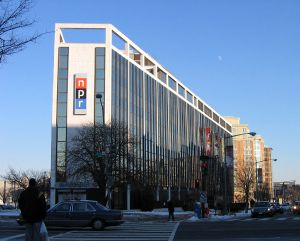
There are several major radio stations serving the metro area, with a wide variety of musical interests. The Contemporary music station (and arguably the most popular) is WIHT 99.5 FM (Hot 99.5) located in Rockville, Maryland. Rock stations include WTGB 94.7 FM (The Globe - Triple A) and WWDC 101.1 FM (DC 101 - active/alternative rock). Urban stations include WPGC 95.5 FM (rhythmic top 40/urban contemporary), WHUR 96.3 FM (Howard University urban adult contemporary station), WMMJ 102.3 FM (urban adult contemporary), WKYS 93.9 FM (urban contemporary) and Radio CPR 97.5 FM (a popular pirate radio station broadcasting in the area around Mount Pleasant, Adams Morgan and Columbia Heights). Two major contemporary Christian music stations in the region are WGTS 91.9 FM (of Takoma Park) and WPER 89.9 (of Warrenton, Virginia).
Stations that concentrate on talk and sports include WJFK 106.7 FM (FM talk), WMAL 630 AM (conservative talk), WWRC 1260 AM (progressive talk), WOL 1450 AM (urban talk), WTEM 980 AM (sports talk), Triple X ESPN Radio 92.7 FM/94.3 FM/730 AM (sports talk station controlled by Washington Redskins owner Daniel Snyder), WAVA 105.1 FM (Christian talk radio), WTOP 103.5 FM (news) and WTWP 1500 AM/107.7 FM (Washington Post Radio-news/talk). Radio duos Don and Mike and Ron and Fez both had great success on WJFK, although the latter now broadcast on D.C.-based XM Satellite Radio via the network's New York studio.
WOL 1450 AM, WKYS 93.9 FM, and WMMJ 102.3 are owned by Washington's Radio One, the largest African American media conglomerate in the country. It was founded by Cathy Hughes, a prominent figure in Washington radio since her days at Howard University's WHUR.
There are two National Public Radio (NPR) affiliates: WAMU 88.5 FM (NPR and Public Radio International programming, community programming, and BBC news), broadcast from the American University, and WETA 90.9 FM (around-the-clock classical music). Other stations include WASH 97.1 FM (adult contemporary), WMZQ 98.7 FM (country music), WLZL El Zol 99.1 FM (Latin/Tropical), WBIG 100.3 FM (classic hits), WPRS Praise 104.1 FM (gospel), WPGC 1580 AM (gospel), WPFW 89.3 FM (jazz and progressive talk), WJZW 105.9 FM (smooth jazz), and WRQX 107.3 FM (hot adult contemporary). In some parts of the city and suburban Maryland, listeners can hear WMUC 88.1 FM (freeform) the only remaining FM college radio station in the area. Additionally, most major radio stations from Baltimore can be heard in the Washington metropolitan area.
XM Satellite Radio and NPR are based in Washington. The Voice of America, the U.S. government's international broadcasting service, is headquartered in Washington.
Infrastructure
Health systems
A prominent hospital in Washington, D.C. is Walter Reed Army Medical Center, the U.S. Army's premier medical center on the east coast. The 5,500-bed Walter Reed provides care for dependents, active-duty and retired personnel from all branches of the armed forces, as well as the President, Vice President, and Congressmen. The hospital, however, is scheduled to move to a newer and larger facility in nearby Bethesda, Maryland, forcing its closure in 2011.
Armed Forces veterans also receive care at the Veterans' Affairs Medical Center[37] in the grounds of the Old Soldier's Home.
Washington Hospital Center is the largest hospital campus in the District, and both the largest private and largest non-profit hospital in the Metropolitan Area. It is consistently ranked among the top hospitals in the United States, notably by HCIA[38] and U.S. News and World Report.[39]
Immediately adjacent to the Washington Hospital Center campus in central Washington are the National Rehabilitation Hospital, and Children's National Medical Center (although Children's has satellite centers scattered across the city). Both, like WHC, are among the highest-ranked hospitals in the nation. The Specialty Hospital of Washington is a long-term acute care facility, established in 1995 in Northeast D.C.
Three of the universities in Washington have associated medical schools — and, subsequently, hospitals: George Washington, Georgetown and Howard University. All three are teaching hospitals and are highly regarded institutions. In particular, George Washington University Medical Center is noteworthy as the medical center whose doctors saved the life of President Ronald Reagan when he was shot in 1981. The GWU Emergency Room facility, in fact, is named for Reagan.[40] Georgetown University Medical Center is home to the Lombardi Cancer Center, which is the sole comprehensive cancer center in the Washington, D.C. region.
The oldest continuously operating hospital in the city is Providence Hospital in Northeast D.C., chartered by Abraham Lincoln in 1861. There are three additional private, non-profit community hospitals in Washington: Sibley Memorial Hospital in upper Northwest, Hadley Memorial, a long-term acute care facility in lower Southwest, and Greater Southeast Community Hospital in Southeast, which generally serves the population east of the Anacostia River.
Until 2001, D.C. General Hospital operated near Capitol Hill as the city's only public health-care facility. Mayor Anthony A. Williams had the hospital (which lost several million dollars a year) shut down in an attempt to manage the city's recovery from bankruptcy. The majority of its patient base has since been picked up by Greater Southeast and Prince George's Hospital in Maryland. Mayor Williams in 2005 proposed a new state-of-the-art facility, the National Capital Medical Center, be built on the D.C. General campus as a joint project of the city and Howard University. However, higher-than-expected cost analyses and questions about the proposed hospital's public-health-care capacity caused support for the project to dwindle rapidly. In 2006, the Mayor instead announced support for a $72 million "healthplex" on the D.C. General grounds.[41]
In addition, there are three psychiatric hospitals in Washington, D.C.: Riverside Hospital, Saint Elizabeth's Hospital and the Psychiatric Institute of Washington.
Utilities
Water is supplied to Washington D.C. from the Potomac River at the Dalecarlia and McMillan Reservoirs, and is treated by the D.C. Water and Sewer Authority.[42] Though, the safety and quality of tap water is marginal, with unsafe levels of chlorine and lead in water provided to many parts of the city.[43]
Looking to the future
Washington has some of the highest-cost, lowest-quality services in the entire region, including a high-cost school system with excessive administrative staff but shabby schools and low learning standards. Prosperity in the late 1990s and early 2000s including an influx of young professional residents, lessened public pressure on the mayor, but he still faced daunting urban renewal, public health, and public education challenges.
ReferencesISBN links support NWE through referral fees
- ↑ 1.0 1.1 Cite error: Invalid
<ref>tag; no text was provided for refs namedCensusEst - ↑ Washington Post. Population Revision 'Big Deal' For D.C.. Retrieved 2006-07-26.
- ↑ Georgetown Historic District, National Park Service. Accessed June 6, 2007. "Congress incorporated Georgetown as part of Washington City in 1871."
- ↑ http://www.irs.gov/pub/irs-soi/04db06co.xls
- ↑ http://www.fedstats.gov/qf/states/11000.html
- ↑ "Anniversary of Washington, D.C., as Nation’s Capital." United States Census Bureau (Facts for Features). December 1, 2003. Retrieved on April 28, 2006.
- ↑ "White House target of Flight 93, officials say", CNN.com, May 23, 2002.
- ↑ "Al-Jazeera offers accounts of 9/11 planning", CNN, September 12, 2002.
- ↑ [Seidel, Jeff. "New ballpark design unveiled: Nationals aiming to begin play in new stadium in 2008", MLB.com, March 14, 2006. Accessed June 14, 2007.
- ↑ http://www.safestreetsdc.com/subpages/murdercap.html
- ↑ http://mpdc.dc.gov/mpdc/cwp/view,a,1239,q,561242,mpdcNav_GID,1523,mpdcNav,%7C.asp
- ↑ "America's Safest (and Most Dangerous) Cities." Morgan Quitno Press. November 21, 2005. Retrieved on July 8, 2006.
- ↑ Mayors Against Illegal Guns: Coalition Members. Retrieved on June 13, 2007
- ↑ Klein, Allison, "Police Chief Declares D.C. Crime Emergency", Washington Post, July 12, 2006. Retrieved 2006-07-21.
- ↑ Whitman, Ray D.; Siegmund, Fred. "District of Columbia Employment Projections by Industry and Occupation, 2002-2012." D.C. Department of Employment Services, Office of Labor Market Research and Information. June 1, 2005. Retrieved on July 9, 2007.
- ↑ "2007 Fortune 500 Annual Ranking." Fortune Magazine. April 30, 2007. Retrieved on July 9, 2007.
- ↑ "[1]." Globalization and World Cities Network. Retrieved on July 9, 2007.
- ↑ "[2]." 2006 AFIRE Annual Survey. Retrieved on July 9, 2007.
- ↑ "[3]." International Investors Broaden Investment Strategies. Retrieved on July 9, 2007.
- ↑ Whitman, Ray D.; Siegmund, Fred. "District of Columbia Employment Projections by Industry and Occupation, 2002-2012." D.C. Department of Employment Services, Office of Labor Market Research and Information. June 1, 2005. Retrieved on August 31, 2006.
- ↑ Bureau of Economic Analysis, U.S. Department of Commerce.
- ↑ "2006 MAYOR'S CHALLENGE: Where Are the Best Metros for Future Business Locations?", Expansion Magazine, August 7, 2006.
- ↑ "Top 200 Chief Executive Officers of the Major Employers in the District of Columbia." Department of Employment Services, Office of Labor Market Research and Information. September 2004. Retrieved on June 6, 2006.
- ↑ DISB Press Release. District Adopts New Captive Insurance Laws.
- ↑ Insurance Information Institute. Captives & Other Risk-Financing Options.
- ↑ Montgomery, Lori; Silverman, Elissa. "Population Revision 'Big Deal' For D.C.." Washington Post. July 22, 2006. Retrieved on August 31, 2006.
- ↑ HISPANIC OR LATINO ORIGIN BY SPECIFIC ORIGIN - Universe: TOTAL POPULATION for Washington city, District of Columbia 2005 American Community Survey. Accessed June 25, 2007.
- ↑ "Richest Cities In The U.S.", Forbes, October 27, 2005. Accessed June 9, 2007.
- ↑ 29.0 29.1 "Report: Adult illiteracy rate high in nation's capital." CNN. March 19, 2007. Retrieved on March 19, 2007.
- ↑ Report: U.S. Census
- ↑ "Most spoken languages in District of Columbia." Modern Language Association. Retrieved on March 19, 2007.
- ↑ Bergman, Mike. "Washington, D.C., Has Huge Increase. Census Bureau Releases First-Ever Data On Daytime Populations for Cities and Counties." (press release). United States Census Bureau. October 20, 2005. Retrieved on August 31, 2006.
- ↑ What’s in the FY 2007 Budget for Education?. DC Fiscal Policy Institute. Retrieved 2007-05-06.
- ↑ "Martin Luther King, Jr. Memorial Library - A Brief History." DC Library. Retrieved on August 31, 2006.
- ↑ Becker, Ralph E. (1990). Miracle on the Potomac. Bartleby Press.
- ↑ Maynard, John, "Channel 5 to Roll Out A 6 O'Clock Newscast", The Washington Post, 2007-08-14, p. C07.
- ↑ http://www1.va.gov/directory/guide/facility.asp?ID=143&dnum=ALL&map=1
- ↑ http://www.medstarhealth.org/body.cfm?id=35
- ↑ http://www.usnews.com/usnews/health/best-hospitals/directory/glance_6330120.htm
- ↑ http://www.gwemed.edu/reaganinst.htm
- ↑ http://www.washingtonpost.com/wp-dyn/content/article/2006/11/13/AR2006111301210.html?nav=rss_metro/dc
- ↑ Facilities. D.C. Water and Sewer Authority. Retrieved 2007-07-19.
- ↑ Leonnig, Carol D.. "New Fears Raised Over Safety of D.C. Water", The Washington Post, July 19, 2007.
External links
- Official Website
- Washington, D.C. Convention and Tourism Corporation
- Metropolitan Police Department
- Guide to Washington, D.C., Materials from the Library of Congress
- USGS real-time, geographic, and other scientific resources of Washington, D.C.
- The L'Enfant and MacMillan city plans for Washington, D.C.
- Travel guide to Washington, D.C. from Wikitravel
- Washington DC Community
Webcams:
- Washington Monument Capitol Building Webcam
- Washington Monument Capitol Building Potomac River Webcam
Maps:
-
- Maps from WikiMapia, Google Maps, Live Search Maps, Yahoo! Maps, or MapQuest
- Topographic maps from TopoZone
| District of Columbia Capital of the United States | |
| Topics | Culture |
History | Geography | Economy | Demographics | Media | Music | Sports | Transportation | Emancipation Day |
| Government | Home rule |
Voting rights | Former Mayors | Current Mayor | Statehood movement | Retrocession |
| Neighborhoods of the District of Columbia | |
|---|---|
Adams Morgan · American University Park · Anacostia · Arboretum · Barnaby Woods · Barney Circle · Barry Farm · Bellevue · Benning Heights · Benning Ridge · Benning · Berkley · Bloomingdale · Brentwood · Brightwood · Brightwood Park · Brookland · Buena Vista · Burleith · Burrville · Capitol Hill · Capitol View · Carver Langston · Cathedral Heights · Central Northeast/Mahaning Heights · Chevy Chase · Chinatown · Civic Betterment · Cleveland Park · Colonial Village · Colony Hill · Columbia Heights · Congress Heights · Crestwood · Deanwood · Douglass · Downtown · Dupont Circle · Dupont Park · Eastland Gardens · Eckington · Edgewood · Embassy Row · Fairfax Village · Fairlawn · Foggy Bottom · Forest Hills · Fort Davis · Fort Dupont · Fort Lincoln · Fort Totten · Foxhall · Friendship Heights · Garfield Heights · Gateway · Georgetown · Glover Park · Good Hope · Greenway · Hawthorne · Hillbrook · Hillcrest · Ivy City · Judiciary Square · Kalorama · Kenilworth · Kent · Kingman Park · Knox Hill · Langdon · Lanier Heights · Le Droit Park · Lincoln Heights · Logan Circle · Manor Park · Marshall Heights · Massachusetts Heights · Mayfair · McLean Gardens · Michigan Park · Mount Pleasant · Mount Vernon Square · Navy Yard/Near Southeast · Naylor Gardens · Near Northeast · NoMa · North Cleveland Park · North Michigan Park · North Portal Estates · Northeast Boundary · Observatory Circle · The Palisades · Park Naylor · Park View · Penn Branch · Penn Quarter · Petworth · Pleasant Hill · Pleasant Plains · Potomac Heights · Queens Chapel · Randle Highlands · Reed-Cooke · Riggs Park · River Terrace · Rock Creek Gardens · Shaw · Shepherd Park · Shipley Terrace · Sixteenth Street Heights · Skyland · Southwest Federal Center · Southwest Waterfront · Spring Valley · Stronghold/Metropolis View · Sursum Corda · Swampoodle · Takoma · Tenleytown · Trinidad · Truxton Circle · Twining · University Heights · Wakefield · Washington Highlands · Wesley Heights · West End · Woodland · Woodland-Normanstone Terrace · Woodley Park · Woodridge |
| Location of the capital of the United States | |
|---|---|
| 1774 First Continental Congress | Philadelphia |
| 1775 – 1781 Second Continental Congress | Philadelphia → Baltimore → Lancaster → York |
| 1781 – 1789 Congress of the Confederation | Philadelphia → Princeton → Annapolis → Trenton → New York |
| 1789 to date United States Congress | New York → Philadelphia → Washington |
|
| |||||||
Credits
New World Encyclopedia writers and editors rewrote and completed the Wikipedia article in accordance with New World Encyclopedia standards. This article abides by terms of the Creative Commons CC-by-sa 3.0 License (CC-by-sa), which may be used and disseminated with proper attribution. Credit is due under the terms of this license that can reference both the New World Encyclopedia contributors and the selfless volunteer contributors of the Wikimedia Foundation. To cite this article click here for a list of acceptable citing formats.The history of earlier contributions by wikipedians is accessible to researchers here:
The history of this article since it was imported to New World Encyclopedia:
Note: Some restrictions may apply to use of individual images which are separately licensed.
